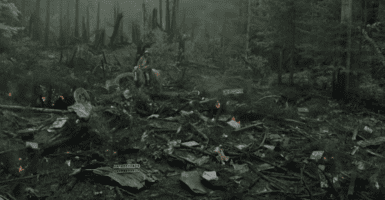Scientists Say Saturn’s Rings Are Disappearing
It looks like the rings of Saturn might not be around forever. Scientists are saying that they are slowly disappearing from sight.

Kids making models of our solar system in school might one day have a much, much easier time with one of the planets. No longer will they have to wrangle some way to have one of them not just be a plain old orb. That’s because scientists are suggesting that Saturn might one day lose its unique feature, that thing that makes it one of the most pleasing to look at. There is a prevailing thought that Saturn is losing its rings and one day will just be a regular, boring planet like the rest of the ones in the solar system.
According to The Atlantic (via Futurism), the rings around Saturn will be going away eventually, though thankfully (at least from an observational level) the absence won’t be felt for a long, long time. In a process called “ring rain”, the pieces of space particles that make up the rings around Saturn will no longer exist in orbit around the planet, slowly exiting this field and therefore eliminating the rings altogether.
Essentially, the particles and other pieces that make up the rings of Saturn are affected by the Sun’s radiation which in turn electrifies them. This sends them into a spiraling orbit around Saturn that eventually lands them too close to the atmosphere and they are pulled in. It’s almost like they are spinning down the planetary drain and we will never see them again. Bye, bye rings of Saturn.

But school kids making models, and those just liking to stare at the heavens and see the distinctive rings of Saturn needn’t worry too much about the short-term effects. That’s because the rough estimate is that they will be around for the next 300 million years (give or take a couple of million years). The process of the ring rain is a very slow one and observers are just starting to notice the effects of the rings, seeing that the area around Saturn has slowly changed over the years. They are simply projecting out what will eventually happen well off in the future.
From a cosmic and galactic perspective, the rings of Saturn are pretty young, likely forming within the last 100 million years. While that might seem like an eternity, in the context of our universe it’s kind of nothing. And images from various NASA spacecraft which have done a pass-by or two show these as a relatively new formation. The rings are made up of chunks of rock and ice that some astronomers believe resulted in a moon of Saturn blowing to bits and spreading out the space debris which remained in the planet’s orbit. Other space pieces like comets and asteroids could have joined the mix as well.
Again, that last piece is still just a theory, scientists aren’t 100% sure how Saturn got its gorgeous rings. But they do seem to be on a consensus that the rings won’t last forever. So you better take a good, long look at them right now. Because your great, great, great (and a lot more greats) grandkids won’t be able to see them at all.












